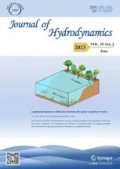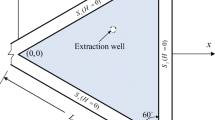Abstract
The mechanism of the fluid flow in low permeability reservoirs is different from that in middle-high permeability reservoirs because of the existence of the Threshold Pressure Gradient (TPG). When the pressure gradient at some location is greater than the TPG, the fluid in porous media begins to flow. By applying the mirror image method and the principle of potential superposition, the steady-state pressure distribution and the stream function for infinite five-spot well patterns can be obtained for a low permeability reservoir with the TPG effect. Based on the streamlines distribution, the flowing and stagnant zones in five-spot well patterns can be clearly seen. By the definition of the effective startup coefficient (SUC), the ratio of the flowing and stagnant zones can be calculated accurately. It is shown that the SUC for five-spot well patterns is not constant, but decreases with the increase of the dimensionless TPG. By increasing the effective permeability of the formation (such as by the acid treatment and the hydraulic fracture), in increasing the injection-production differential pressure or shortening the well space (such as by infilling well), the SUC can be improved. The results of the sensitivity analysis show that a better choice for the SUC enhancement is to shorten the well spacing for small permeability reservoirs and to increase the pressure difference for large permeability reservoirs. This streamline approach can be used to determine the distribution of remaining oil and provide guidance for infilling well.
Similar content being viewed by others
References
SONG Fu-quan, JIANG Ren-jie and BIAN Shu-li. Measurement of threshold pressure gradient of microchannels by static method[J]. Chinese Physics Letters, 2007, 24(7): 1995–1998.
HAO F., CHENG L. S. and HASSAN O. et al. Threshold pressure gradient in ultra-low permeability reservoirs[J]. Petroleum Science and Technology, 2008, 26(9): 1024–1035.
ZENG B., CHENG L. and HAO F. Experiment and mechanism analysis on threshold pressure gradient with different fluids[C]. SPE 140678. Tinapa-Calabar, Nigeria, 2010.
SONG Fu-quan, WANG Jian-dong and LIU Hai-li. Static threshold pressure gradient characteristics of liquid influenced by boundary wettability[J]. Chinese Physics Letters, 2010, 27(2): 024704.
CHENG Lin-song, ZENG Bao-quan and HAO Fei. Mechanism of threshold pressure gradient reduction by surfactant[C]. Flow in Porous Media-from Phenomena to Engineering and Beyond. Wuhan, China, 2009, 170–174.
ZHU W., SONG H. and HUANG X. et al. Pressure characteristics and effective deployment in a water-bearing tight gas reservoir with low-velocity non-Darcy flow[J]. Energy and Fuels, 2011, 25(3): 1111–1117.
SONG Hong-qing, YUE Ming and ZHU Wei-yao et al. Formation pressure analysis of water-bearing tight gas reservoirs with unsteady low-velocity Non-Darcy flow[C]. 2nd International Conference on Manufacturing Science and Engineering. Guilin, China, 2011.
SONG H. Q., ZHU W. Y. and WANG M. et al. A study of effective deployment in ultra-low-permeability reservoirs with non-Darcy flow[J]. Petroleum Science and Technology, 2010, 28(16): 1700–1711.
JI Bing-yu, LI Li and WANG Chun-yan. Oil production calculation for areal well pattern of low-permeability reservoir with non-Darcy seepage flow[J]. Acta petroleum sinica, 2008, 29(2): 256–261(in Chinese).
ZHU Wei-yao, LIU Jin-zi and SONG Hong-qiang et al. Calculation of effective startup degree of non-Darcy flow in low or ultra-low permeability reservoirs[J]. Acta petroleum sinica, 2010, 31(3): 452–457(in Chinese).
MUSKAT M. The flow of homogeneous fluids through porous media[M]. New York, USA: McGraw-Hill, 1937.
LUO Wan-jing, WANG Xiao-dong and CHEN Jianyang. A new method for rapid productivity estimation of 5-spot well pattern[J]. Petroleum exploration and development, 2010, 37(6): 726–731(in Chinese).
POLLOCK D. W. Semianalytical computation of path lines for finite-difference models[J]. Ground Water, 1988, 26(6): 743–750.
LEBLANC J. L., CAUDLE B. H. A streamline model for secondary recovery[J]. SPE Journal, 1971, 11(1): 7–12.
LI Song-quan, CHENG Lin-song and LI Xiu-sheng et al. A new method for determining reasonable well spacing in ultra-low permeability reservoirs[J]. Journal of South-West Petroleum University (Science and Technology Edition), 2008, 30(5): 93–96(in Chinese).
WANG S., HUANG Y. and CIVAN F. Experimental and theoretical investigation of the zaoyuan field heavy oil flow through porous media[J]. Journal of Petroleum Science and Engineering, 2006, 50(2): 83–101.
PRADA A., CIVAN F. Modification of Darcy’s law for the threshold pressure gradient[J]. Journal of Petroleum Science and Engineering, 1999, 22(4): 237–240.
Author information
Authors and Affiliations
Corresponding author
Additional information
Project Supported by the National Natural Science Foundation of China (Grant No. 51204148).
Biography: Luo Wan-jing (1980-), Male, Ph. D., Lecturer
Rights and permissions
About this article
Cite this article
Luo, Wj., Wang, Jl., Wang, Xd. et al. A streamline approach for identification of the flowing and stagnant zones for five-spot well patterns in low permeability reservoirs. J Hydrodyn 25, 710–717 (2013). https://doi.org/10.1016/S1001-6058(13)60416-3
Received:
Revised:
Published:
Issue Date:
DOI: https://doi.org/10.1016/S1001-6058(13)60416-3




